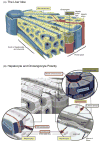Hepatocyte polarity
- PMID: 23720287
- PMCID: PMC3697931
- DOI: 10.1002/cphy.c120009
Hepatocyte polarity
Abstract
Hepatocytes, like other epithelia, are situated at the interface between the organism's exterior and the underlying internal milieu and organize the vectorial exchange of macromolecules between these two spaces. To mediate this function, epithelial cells, including hepatocytes, are polarized with distinct luminal domains that are separated by tight junctions from lateral domains engaged in cell-cell adhesion and from basal domains that interact with the underlying extracellular matrix. Despite these universal principles, hepatocytes distinguish themselves from other nonstriated epithelia by their multipolar organization. Each hepatocyte participates in multiple, narrow lumina, the bile canaliculi, and has multiple basal surfaces that face the endothelial lining. Hepatocytes also differ in the mechanism of luminal protein trafficking from other epithelia studied. They lack polarized protein secretion to the luminal domain and target single-spanning and glycosylphosphatidylinositol-anchored bile canalicular membrane proteins via transcytosis from the basolateral domain. We compare this unique hepatic polarity phenotype with that of the more common columnar epithelial organization and review our current knowledge of the signaling mechanisms and the organization of polarized protein trafficking that govern the establishment and maintenance of hepatic polarity. The serine/threonine kinase LKB1, which is activated by the bile acid taurocholate and, in turn, activates adenosine monophosphate kinase-related kinases including AMPK1/2 and Par1 paralogues has emerged as a key determinant of hepatic polarity. We propose that the absence of a hepatocyte basal lamina and differences in cell-cell adhesion signaling that determine the positioning of tight junctions are two crucial determinants for the distinct hepatic and columnar polarity phenotypes.
Figures











Similar articles
-
The unique polarity phenotype of hepatocytes.Exp Cell Res. 2014 Nov 1;328(2):276-83. doi: 10.1016/j.yexcr.2014.06.006. Epub 2014 Jun 20. Exp Cell Res. 2014. PMID: 24956563 Free PMC article. Review.
-
The special case of hepatocytes: unique tissue architecture calls for a distinct mode of cell division.Bioarchitecture. 2014 Mar-Apr;4(2):47-52. doi: 10.4161/bioa.29012. Epub 2014 Apr 25. Bioarchitecture. 2014. PMID: 24769852 Free PMC article.
-
Structural and functional hepatocyte polarity and liver disease.J Hepatol. 2015 Oct;63(4):1023-37. doi: 10.1016/j.jhep.2015.06.015. Epub 2015 Jun 24. J Hepatol. 2015. PMID: 26116792 Free PMC article. Review.
-
Par1b promotes hepatic-type lumen polarity in Madin Darby canine kidney cells via myosin II- and E-cadherin-dependent signaling.Mol Biol Cell. 2007 Jun;18(6):2203-15. doi: 10.1091/mbc.e07-02-0095. Epub 2007 Apr 4. Mol Biol Cell. 2007. PMID: 17409351 Free PMC article.
-
Pluripotent stem cell-derived bile canaliculi-forming hepatocytes to study genetic liver diseases involving hepatocyte polarity.J Hepatol. 2019 Aug;71(2):344-356. doi: 10.1016/j.jhep.2019.03.031. Epub 2019 Apr 6. J Hepatol. 2019. PMID: 30965071
Cited by
-
Intratumoral heterogeneity of hepatocellular carcinoma: From single-cell to population-based studies.World J Gastroenterol. 2020 Jul 14;26(26):3720-3736. doi: 10.3748/wjg.v26.i26.3720. World J Gastroenterol. 2020. PMID: 32774053 Free PMC article. Review.
-
Multiscale and Multimodal Optical Imaging of the Ultrastructure of Human Liver Biopsies.Front Physiol. 2021 Feb 17;12:637136. doi: 10.3389/fphys.2021.637136. eCollection 2021. Front Physiol. 2021. PMID: 33679449 Free PMC article.
-
Expression, Prognostic Value, and Functional Mechanism of Polarity-Related Genes in Hepatocellular Carcinoma.Int J Mol Sci. 2022 Oct 24;23(21):12784. doi: 10.3390/ijms232112784. Int J Mol Sci. 2022. PMID: 36361574 Free PMC article.
-
The Many Roles of Cell Adhesion Molecules in Hepatic Fibrosis.Cells. 2019 Nov 24;8(12):1503. doi: 10.3390/cells8121503. Cells. 2019. PMID: 31771248 Free PMC article. Review.
-
A Novel Milli-fluidic Liver Tissue Chip with Continuous Recirculation for Predictive Pharmacokinetics Applications.AAPS J. 2023 Oct 27;25(6):102. doi: 10.1208/s12248-023-00870-x. AAPS J. 2023. PMID: 37891356
References
-
- Ala A, Walker AP, Ashkan K, Dooley JS, Schilsky ML. Wilson’s disease. Lancet. 2007;369:397–408. - PubMed
-
- Alessi DR, Sakamoto K, Bayascas JR. LKB1-dependent signaling pathways. Annu Rev Biochem. 2006;75:137–163. - PubMed
-
- Almeida CG, Yamada A, Tenza D, Louvard D, Raposo G, Coudrier E. Myosin 1b promotes the formation of post-Golgi carriers by regulating actin assembly and membrane remodelling at the trans-Golgi network. Nat Cell Biol. 2011;13:779–789. - PubMed
Publication types
MeSH terms
Grants and funding
LinkOut - more resources
Full Text Sources
Other Literature Sources

